Clinical Med 2: Healthcare Assignment - Nephron Damage and More
VerifiedAdded on 2023/06/03
|8
|1671
|426
Homework Assignment
AI Summary
This document provides a comprehensive solution to a Clinical Med 2 assignment, addressing key concepts in healthcare. It begins by explaining the progression from nephron damage to chronic kidney disease and the underlying mechanisms. The assignment then identifies and explains signs and symptoms of pulmonary alterations, followed by a discussion of pharmacological agents used to treat asthma, including corticosteroids, leukotriene modifiers, and others. The document also details the progression of airway obstruction in asthma leading to respiratory failure. Furthermore, it explores non-pharmacological treatments for atopic dermatitis, and pharmacological interventions for acne. The assignment also addresses the causes of pressure ulcers in immobile patients, along with pharmacological and non-pharmacological treatment strategies for osteoporosis. Finally, the document describes the pathophysiology of rheumatoid arthritis, encompassing immune system processes and the role of citrullinated peptides. The document is a valuable resource for students seeking to understand and excel in their Clinical Med 2 coursework.
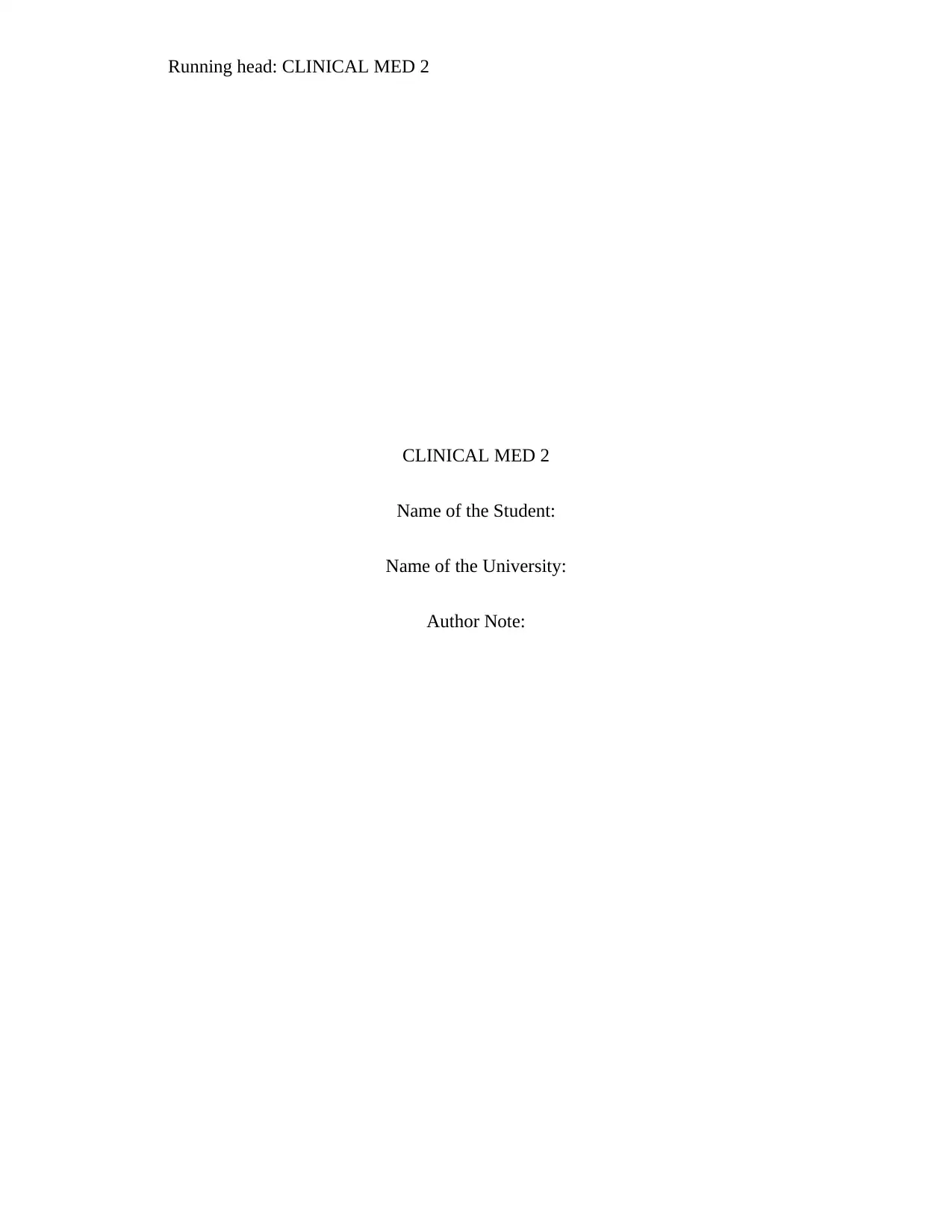
Running head: CLINICAL MED 2
CLINICAL MED 2
Name of the Student:
Name of the University:
Author Note:
CLINICAL MED 2
Name of the Student:
Name of the University:
Author Note:
Paraphrase This Document
Need a fresh take? Get an instant paraphrase of this document with our AI Paraphraser
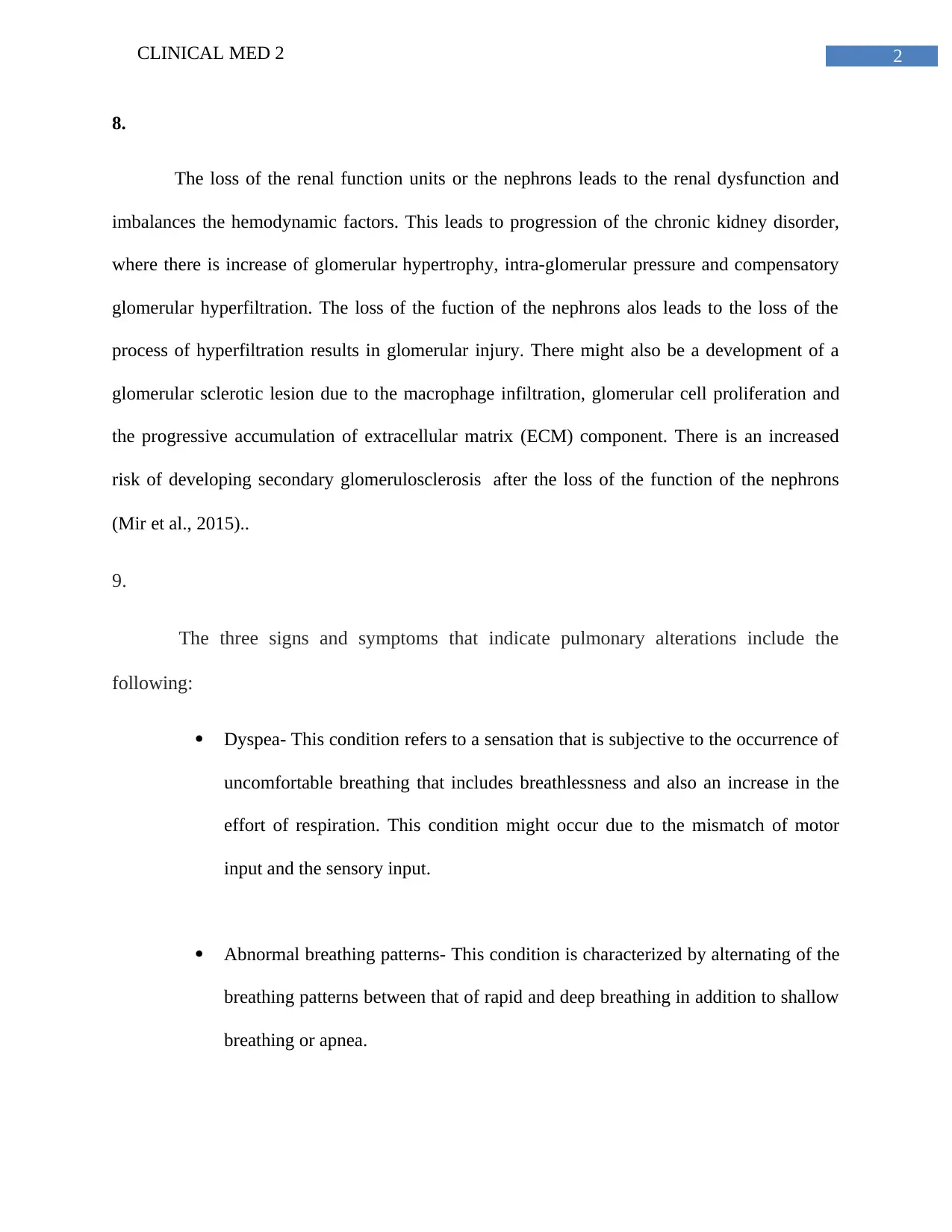
2CLINICAL MED 2
8.
The loss of the renal function units or the nephrons leads to the renal dysfunction and
imbalances the hemodynamic factors. This leads to progression of the chronic kidney disorder,
where there is increase of glomerular hypertrophy, intra-glomerular pressure and compensatory
glomerular hyperfiltration. The loss of the fuction of the nephrons alos leads to the loss of the
process of hyperfiltration results in glomerular injury. There might also be a development of a
glomerular sclerotic lesion due to the macrophage infiltration, glomerular cell proliferation and
the progressive accumulation of extracellular matrix (ECM) component. There is an increased
risk of developing secondary glomerulosclerosis after the loss of the function of the nephrons
(Mir et al., 2015)..
9.
The three signs and symptoms that indicate pulmonary alterations include the
following:
Dyspea- This condition refers to a sensation that is subjective to the occurrence of
uncomfortable breathing that includes breathlessness and also an increase in the
effort of respiration. This condition might occur due to the mismatch of motor
input and the sensory input.
Abnormal breathing patterns- This condition is characterized by alternating of the
breathing patterns between that of rapid and deep breathing in addition to shallow
breathing or apnea.
8.
The loss of the renal function units or the nephrons leads to the renal dysfunction and
imbalances the hemodynamic factors. This leads to progression of the chronic kidney disorder,
where there is increase of glomerular hypertrophy, intra-glomerular pressure and compensatory
glomerular hyperfiltration. The loss of the fuction of the nephrons alos leads to the loss of the
process of hyperfiltration results in glomerular injury. There might also be a development of a
glomerular sclerotic lesion due to the macrophage infiltration, glomerular cell proliferation and
the progressive accumulation of extracellular matrix (ECM) component. There is an increased
risk of developing secondary glomerulosclerosis after the loss of the function of the nephrons
(Mir et al., 2015)..
9.
The three signs and symptoms that indicate pulmonary alterations include the
following:
Dyspea- This condition refers to a sensation that is subjective to the occurrence of
uncomfortable breathing that includes breathlessness and also an increase in the
effort of respiration. This condition might occur due to the mismatch of motor
input and the sensory input.
Abnormal breathing patterns- This condition is characterized by alternating of the
breathing patterns between that of rapid and deep breathing in addition to shallow
breathing or apnea.
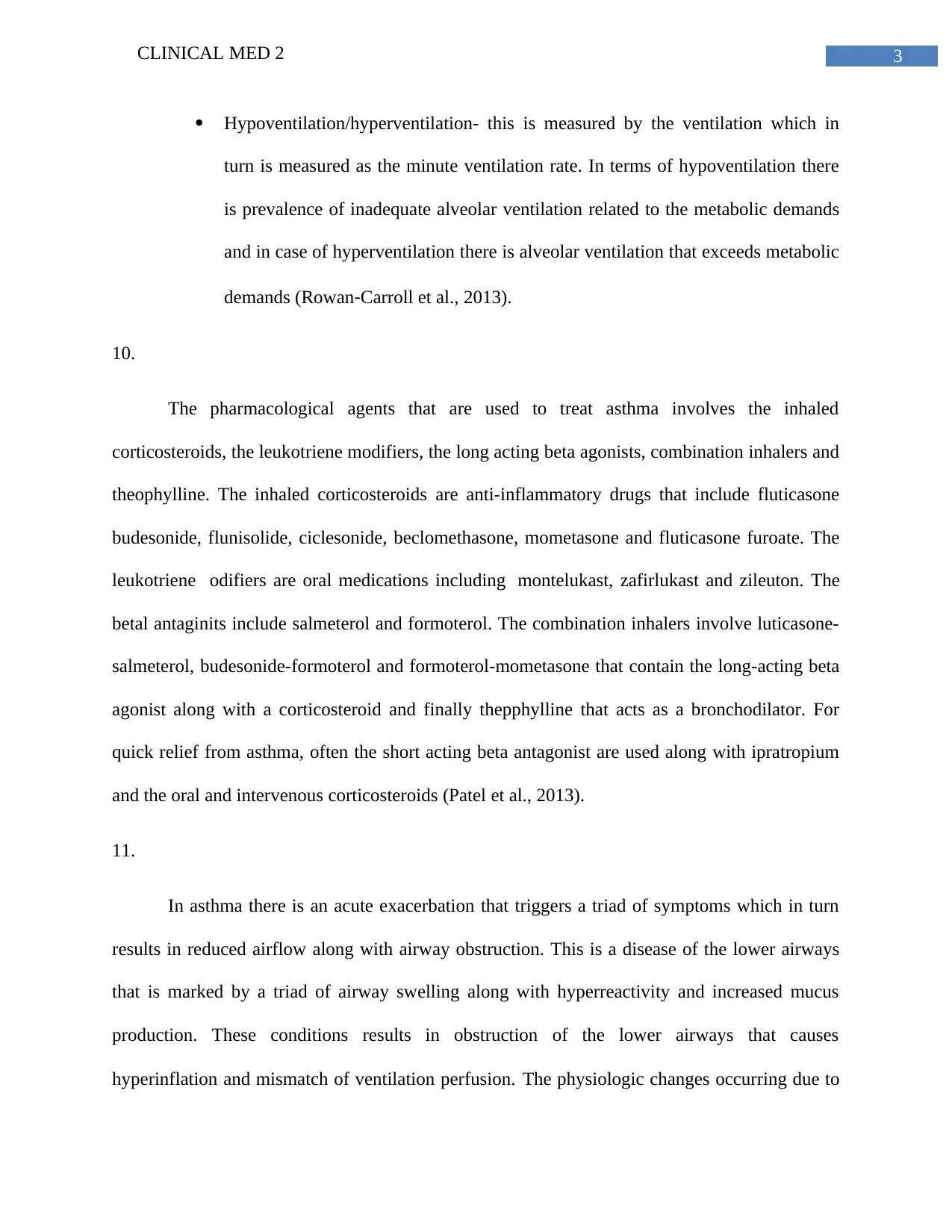
3CLINICAL MED 2
Hypoventilation/hyperventilation- this is measured by the ventilation which in
turn is measured as the minute ventilation rate. In terms of hypoventilation there
is prevalence of inadequate alveolar ventilation related to the metabolic demands
and in case of hyperventilation there is alveolar ventilation that exceeds metabolic
demands (Rowan‐Carroll et al., 2013).
10.
The pharmacological agents that are used to treat asthma involves the inhaled
corticosteroids, the leukotriene modifiers, the long acting beta agonists, combination inhalers and
theophylline. The inhaled corticosteroids are anti-inflammatory drugs that include fluticasone
budesonide, flunisolide, ciclesonide, beclomethasone, mometasone and fluticasone furoate. The
leukotriene odifiers are oral medications including montelukast, zafirlukast and zileuton. The
betal antaginits include salmeterol and formoterol. The combination inhalers involve luticasone-
salmeterol, budesonide-formoterol and formoterol-mometasone that contain the long-acting beta
agonist along with a corticosteroid and finally thepphylline that acts as a bronchodilator. For
quick relief from asthma, often the short acting beta antagonist are used along with ipratropium
and the oral and intervenous corticosteroids (Patel et al., 2013).
11.
In asthma there is an acute exacerbation that triggers a triad of symptoms which in turn
results in reduced airflow along with airway obstruction. This is a disease of the lower airways
that is marked by a triad of airway swelling along with hyperreactivity and increased mucus
production. These conditions results in obstruction of the lower airways that causes
hyperinflation and mismatch of ventilation perfusion. The physiologic changes occurring due to
Hypoventilation/hyperventilation- this is measured by the ventilation which in
turn is measured as the minute ventilation rate. In terms of hypoventilation there
is prevalence of inadequate alveolar ventilation related to the metabolic demands
and in case of hyperventilation there is alveolar ventilation that exceeds metabolic
demands (Rowan‐Carroll et al., 2013).
10.
The pharmacological agents that are used to treat asthma involves the inhaled
corticosteroids, the leukotriene modifiers, the long acting beta agonists, combination inhalers and
theophylline. The inhaled corticosteroids are anti-inflammatory drugs that include fluticasone
budesonide, flunisolide, ciclesonide, beclomethasone, mometasone and fluticasone furoate. The
leukotriene odifiers are oral medications including montelukast, zafirlukast and zileuton. The
betal antaginits include salmeterol and formoterol. The combination inhalers involve luticasone-
salmeterol, budesonide-formoterol and formoterol-mometasone that contain the long-acting beta
agonist along with a corticosteroid and finally thepphylline that acts as a bronchodilator. For
quick relief from asthma, often the short acting beta antagonist are used along with ipratropium
and the oral and intervenous corticosteroids (Patel et al., 2013).
11.
In asthma there is an acute exacerbation that triggers a triad of symptoms which in turn
results in reduced airflow along with airway obstruction. This is a disease of the lower airways
that is marked by a triad of airway swelling along with hyperreactivity and increased mucus
production. These conditions results in obstruction of the lower airways that causes
hyperinflation and mismatch of ventilation perfusion. The physiologic changes occurring due to
⊘ This is a preview!⊘
Do you want full access?
Subscribe today to unlock all pages.

Trusted by 1+ million students worldwide
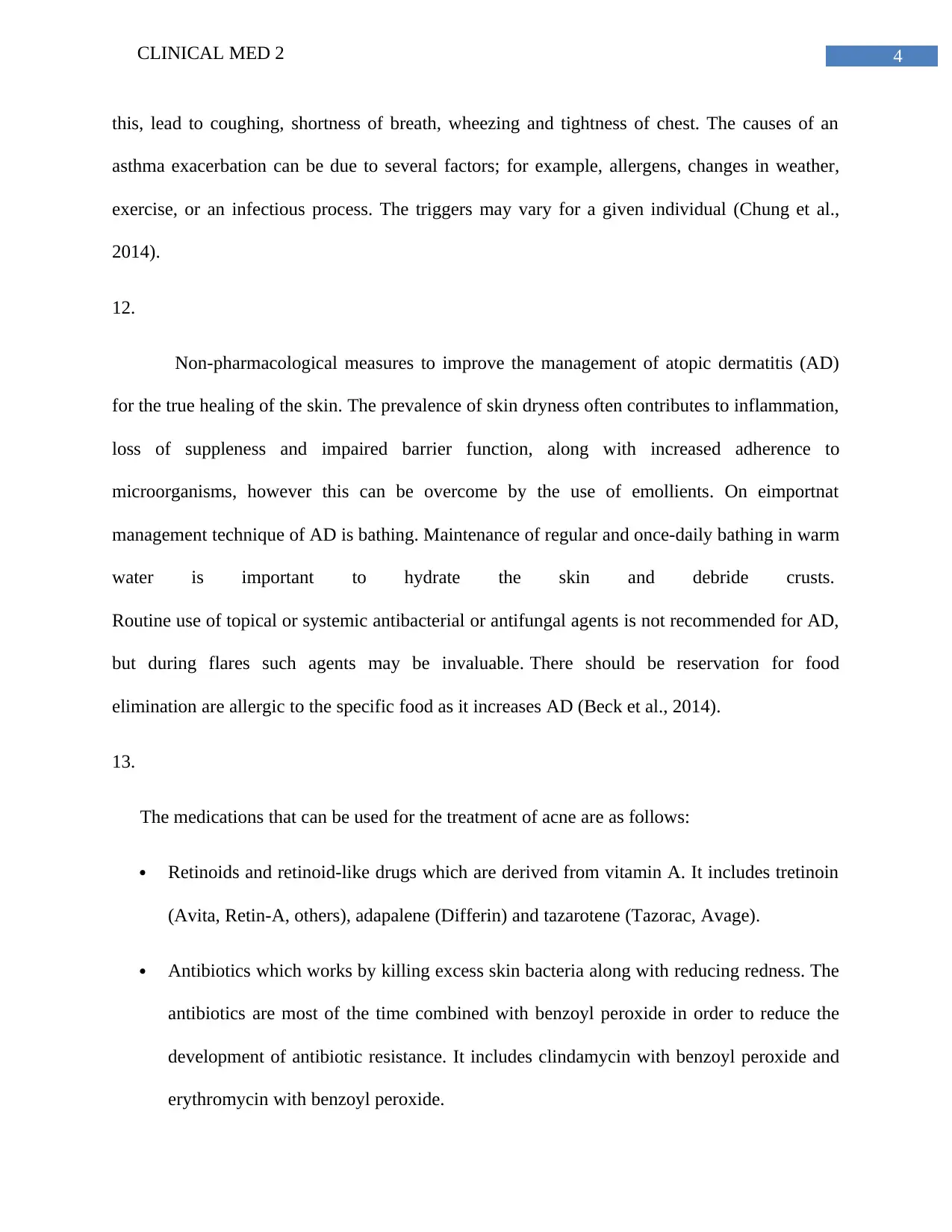
4CLINICAL MED 2
this, lead to coughing, shortness of breath, wheezing and tightness of chest. The causes of an
asthma exacerbation can be due to several factors; for example, allergens, changes in weather,
exercise, or an infectious process. The triggers may vary for a given individual (Chung et al.,
2014).
12.
Non-pharmacological measures to improve the management of atopic dermatitis (AD)
for the true healing of the skin. The prevalence of skin dryness often contributes to inflammation,
loss of suppleness and impaired barrier function, along with increased adherence to
microorganisms, however this can be overcome by the use of emollients. On eimportnat
management technique of AD is bathing. Maintenance of regular and once-daily bathing in warm
water is important to hydrate the skin and debride crusts.
Routine use of topical or systemic antibacterial or antifungal agents is not recommended for AD,
but during flares such agents may be invaluable. There should be reservation for food
elimination are allergic to the specific food as it increases AD (Beck et al., 2014).
13.
The medications that can be used for the treatment of acne are as follows:
Retinoids and retinoid-like drugs which are derived from vitamin A. It includes tretinoin
(Avita, Retin-A, others), adapalene (Differin) and tazarotene (Tazorac, Avage).
Antibiotics which works by killing excess skin bacteria along with reducing redness. The
antibiotics are most of the time combined with benzoyl peroxide in order to reduce the
development of antibiotic resistance. It includes clindamycin with benzoyl peroxide and
erythromycin with benzoyl peroxide.
this, lead to coughing, shortness of breath, wheezing and tightness of chest. The causes of an
asthma exacerbation can be due to several factors; for example, allergens, changes in weather,
exercise, or an infectious process. The triggers may vary for a given individual (Chung et al.,
2014).
12.
Non-pharmacological measures to improve the management of atopic dermatitis (AD)
for the true healing of the skin. The prevalence of skin dryness often contributes to inflammation,
loss of suppleness and impaired barrier function, along with increased adherence to
microorganisms, however this can be overcome by the use of emollients. On eimportnat
management technique of AD is bathing. Maintenance of regular and once-daily bathing in warm
water is important to hydrate the skin and debride crusts.
Routine use of topical or systemic antibacterial or antifungal agents is not recommended for AD,
but during flares such agents may be invaluable. There should be reservation for food
elimination are allergic to the specific food as it increases AD (Beck et al., 2014).
13.
The medications that can be used for the treatment of acne are as follows:
Retinoids and retinoid-like drugs which are derived from vitamin A. It includes tretinoin
(Avita, Retin-A, others), adapalene (Differin) and tazarotene (Tazorac, Avage).
Antibiotics which works by killing excess skin bacteria along with reducing redness. The
antibiotics are most of the time combined with benzoyl peroxide in order to reduce the
development of antibiotic resistance. It includes clindamycin with benzoyl peroxide and
erythromycin with benzoyl peroxide.
Paraphrase This Document
Need a fresh take? Get an instant paraphrase of this document with our AI Paraphraser
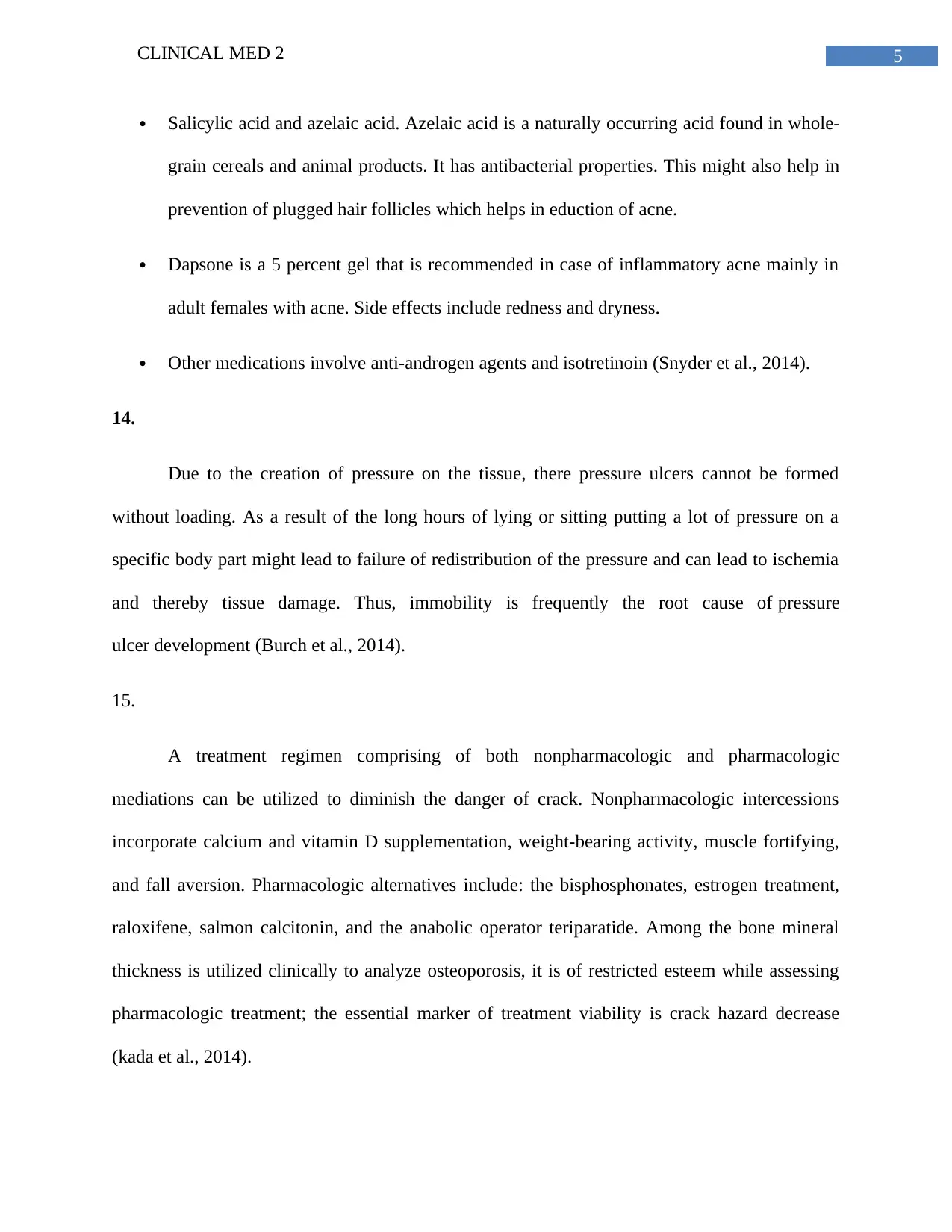
5CLINICAL MED 2
Salicylic acid and azelaic acid. Azelaic acid is a naturally occurring acid found in whole-
grain cereals and animal products. It has antibacterial properties. This might also help in
prevention of plugged hair follicles which helps in eduction of acne.
Dapsone is a 5 percent gel that is recommended in case of inflammatory acne mainly in
adult females with acne. Side effects include redness and dryness.
Other medications involve anti-androgen agents and isotretinoin (Snyder et al., 2014).
14.
Due to the creation of pressure on the tissue, there pressure ulcers cannot be formed
without loading. As a result of the long hours of lying or sitting putting a lot of pressure on a
specific body part might lead to failure of redistribution of the pressure and can lead to ischemia
and thereby tissue damage. Thus, immobility is frequently the root cause of pressure
ulcer development (Burch et al., 2014).
15.
A treatment regimen comprising of both nonpharmacologic and pharmacologic
mediations can be utilized to diminish the danger of crack. Nonpharmacologic intercessions
incorporate calcium and vitamin D supplementation, weight-bearing activity, muscle fortifying,
and fall aversion. Pharmacologic alternatives include: the bisphosphonates, estrogen treatment,
raloxifene, salmon calcitonin, and the anabolic operator teriparatide. Among the bone mineral
thickness is utilized clinically to analyze osteoporosis, it is of restricted esteem while assessing
pharmacologic treatment; the essential marker of treatment viability is crack hazard decrease
(kada et al., 2014).
Salicylic acid and azelaic acid. Azelaic acid is a naturally occurring acid found in whole-
grain cereals and animal products. It has antibacterial properties. This might also help in
prevention of plugged hair follicles which helps in eduction of acne.
Dapsone is a 5 percent gel that is recommended in case of inflammatory acne mainly in
adult females with acne. Side effects include redness and dryness.
Other medications involve anti-androgen agents and isotretinoin (Snyder et al., 2014).
14.
Due to the creation of pressure on the tissue, there pressure ulcers cannot be formed
without loading. As a result of the long hours of lying or sitting putting a lot of pressure on a
specific body part might lead to failure of redistribution of the pressure and can lead to ischemia
and thereby tissue damage. Thus, immobility is frequently the root cause of pressure
ulcer development (Burch et al., 2014).
15.
A treatment regimen comprising of both nonpharmacologic and pharmacologic
mediations can be utilized to diminish the danger of crack. Nonpharmacologic intercessions
incorporate calcium and vitamin D supplementation, weight-bearing activity, muscle fortifying,
and fall aversion. Pharmacologic alternatives include: the bisphosphonates, estrogen treatment,
raloxifene, salmon calcitonin, and the anabolic operator teriparatide. Among the bone mineral
thickness is utilized clinically to analyze osteoporosis, it is of restricted esteem while assessing
pharmacologic treatment; the essential marker of treatment viability is crack hazard decrease
(kada et al., 2014).
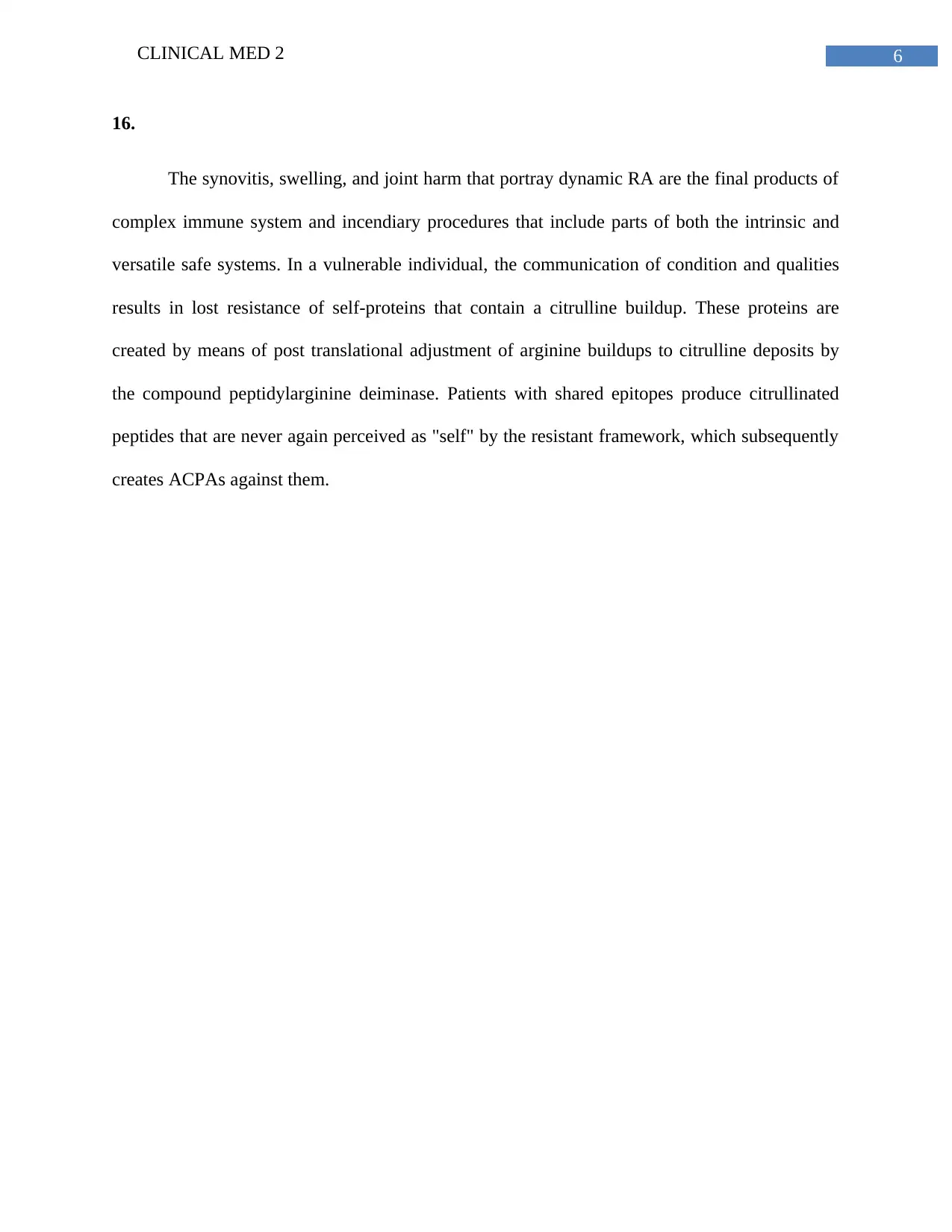
6CLINICAL MED 2
16.
The synovitis, swelling, and joint harm that portray dynamic RA are the final products of
complex immune system and incendiary procedures that include parts of both the intrinsic and
versatile safe systems. In a vulnerable individual, the communication of condition and qualities
results in lost resistance of self-proteins that contain a citrulline buildup. These proteins are
created by means of post translational adjustment of arginine buildups to citrulline deposits by
the compound peptidylarginine deiminase. Patients with shared epitopes produce citrullinated
peptides that are never again perceived as "self" by the resistant framework, which subsequently
creates ACPAs against them.
16.
The synovitis, swelling, and joint harm that portray dynamic RA are the final products of
complex immune system and incendiary procedures that include parts of both the intrinsic and
versatile safe systems. In a vulnerable individual, the communication of condition and qualities
results in lost resistance of self-proteins that contain a citrulline buildup. These proteins are
created by means of post translational adjustment of arginine buildups to citrulline deposits by
the compound peptidylarginine deiminase. Patients with shared epitopes produce citrullinated
peptides that are never again perceived as "self" by the resistant framework, which subsequently
creates ACPAs against them.
⊘ This is a preview!⊘
Do you want full access?
Subscribe today to unlock all pages.

Trusted by 1+ million students worldwide
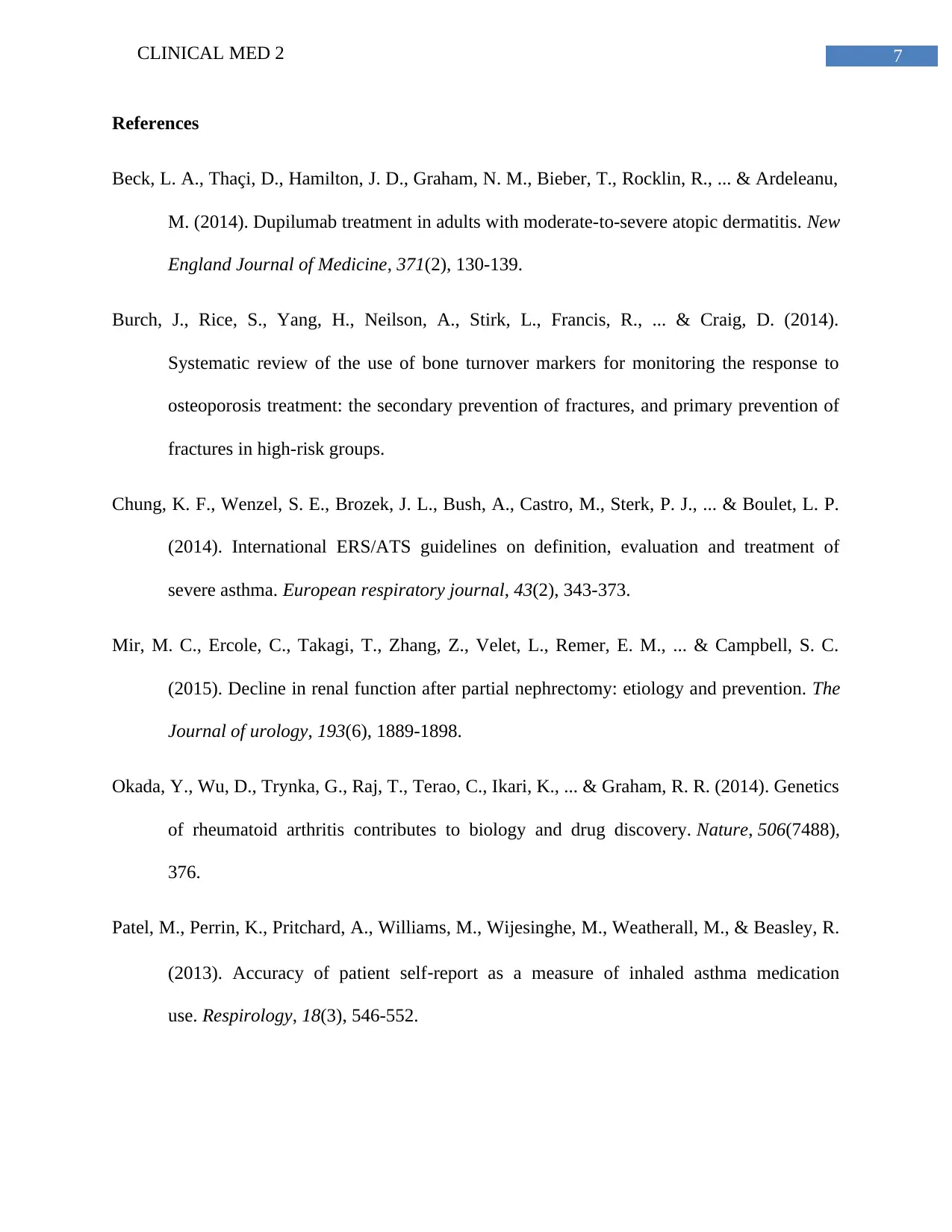
7CLINICAL MED 2
References
Beck, L. A., Thaçi, D., Hamilton, J. D., Graham, N. M., Bieber, T., Rocklin, R., ... & Ardeleanu,
M. (2014). Dupilumab treatment in adults with moderate-to-severe atopic dermatitis. New
England Journal of Medicine, 371(2), 130-139.
Burch, J., Rice, S., Yang, H., Neilson, A., Stirk, L., Francis, R., ... & Craig, D. (2014).
Systematic review of the use of bone turnover markers for monitoring the response to
osteoporosis treatment: the secondary prevention of fractures, and primary prevention of
fractures in high-risk groups.
Chung, K. F., Wenzel, S. E., Brozek, J. L., Bush, A., Castro, M., Sterk, P. J., ... & Boulet, L. P.
(2014). International ERS/ATS guidelines on definition, evaluation and treatment of
severe asthma. European respiratory journal, 43(2), 343-373.
Mir, M. C., Ercole, C., Takagi, T., Zhang, Z., Velet, L., Remer, E. M., ... & Campbell, S. C.
(2015). Decline in renal function after partial nephrectomy: etiology and prevention. The
Journal of urology, 193(6), 1889-1898.
Okada, Y., Wu, D., Trynka, G., Raj, T., Terao, C., Ikari, K., ... & Graham, R. R. (2014). Genetics
of rheumatoid arthritis contributes to biology and drug discovery. Nature, 506(7488),
376.
Patel, M., Perrin, K., Pritchard, A., Williams, M., Wijesinghe, M., Weatherall, M., & Beasley, R.
(2013). Accuracy of patient self‐report as a measure of inhaled asthma medication
use. Respirology, 18(3), 546-552.
References
Beck, L. A., Thaçi, D., Hamilton, J. D., Graham, N. M., Bieber, T., Rocklin, R., ... & Ardeleanu,
M. (2014). Dupilumab treatment in adults with moderate-to-severe atopic dermatitis. New
England Journal of Medicine, 371(2), 130-139.
Burch, J., Rice, S., Yang, H., Neilson, A., Stirk, L., Francis, R., ... & Craig, D. (2014).
Systematic review of the use of bone turnover markers for monitoring the response to
osteoporosis treatment: the secondary prevention of fractures, and primary prevention of
fractures in high-risk groups.
Chung, K. F., Wenzel, S. E., Brozek, J. L., Bush, A., Castro, M., Sterk, P. J., ... & Boulet, L. P.
(2014). International ERS/ATS guidelines on definition, evaluation and treatment of
severe asthma. European respiratory journal, 43(2), 343-373.
Mir, M. C., Ercole, C., Takagi, T., Zhang, Z., Velet, L., Remer, E. M., ... & Campbell, S. C.
(2015). Decline in renal function after partial nephrectomy: etiology and prevention. The
Journal of urology, 193(6), 1889-1898.
Okada, Y., Wu, D., Trynka, G., Raj, T., Terao, C., Ikari, K., ... & Graham, R. R. (2014). Genetics
of rheumatoid arthritis contributes to biology and drug discovery. Nature, 506(7488),
376.
Patel, M., Perrin, K., Pritchard, A., Williams, M., Wijesinghe, M., Weatherall, M., & Beasley, R.
(2013). Accuracy of patient self‐report as a measure of inhaled asthma medication
use. Respirology, 18(3), 546-552.
Paraphrase This Document
Need a fresh take? Get an instant paraphrase of this document with our AI Paraphraser
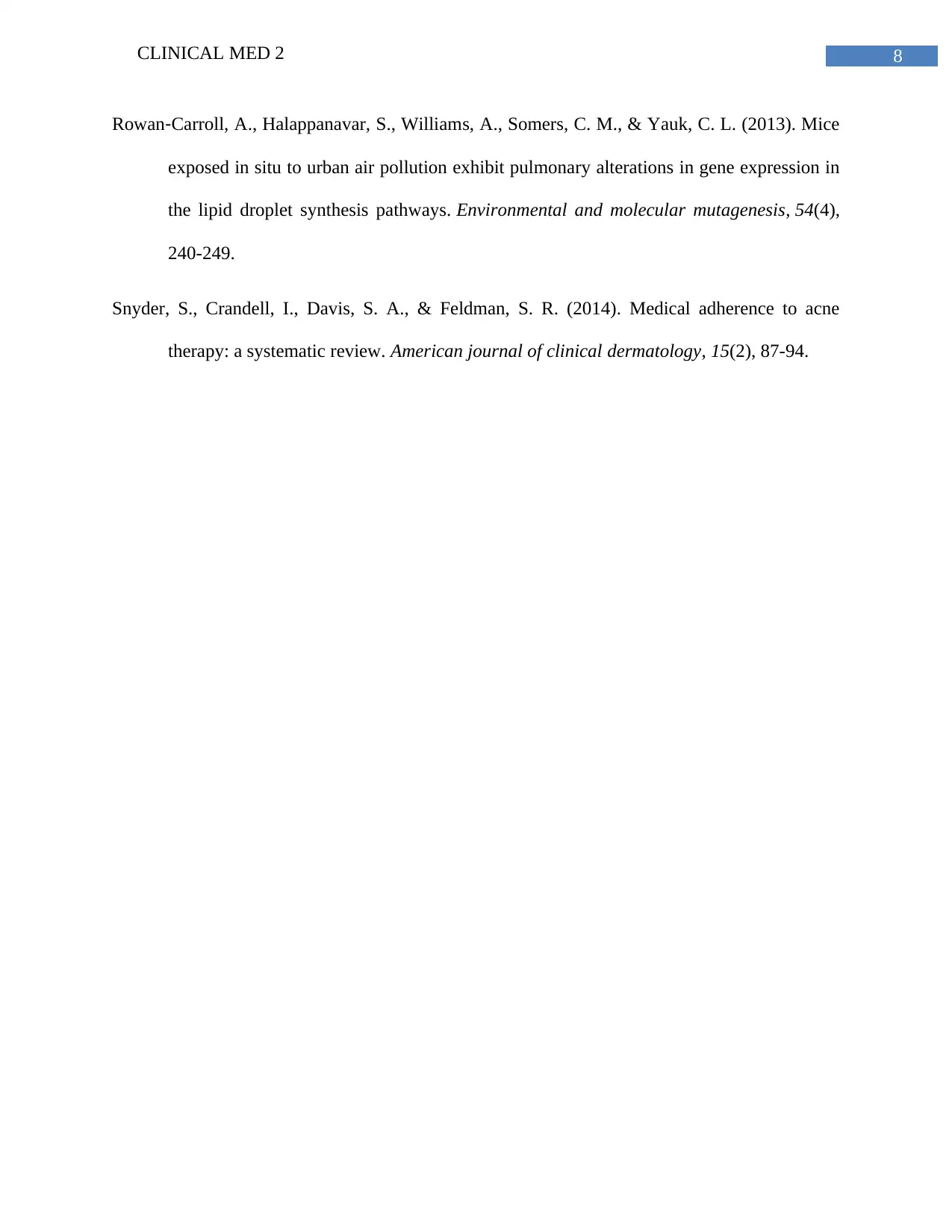
8CLINICAL MED 2
Rowan‐Carroll, A., Halappanavar, S., Williams, A., Somers, C. M., & Yauk, C. L. (2013). Mice
exposed in situ to urban air pollution exhibit pulmonary alterations in gene expression in
the lipid droplet synthesis pathways. Environmental and molecular mutagenesis, 54(4),
240-249.
Snyder, S., Crandell, I., Davis, S. A., & Feldman, S. R. (2014). Medical adherence to acne
therapy: a systematic review. American journal of clinical dermatology, 15(2), 87-94.
Rowan‐Carroll, A., Halappanavar, S., Williams, A., Somers, C. M., & Yauk, C. L. (2013). Mice
exposed in situ to urban air pollution exhibit pulmonary alterations in gene expression in
the lipid droplet synthesis pathways. Environmental and molecular mutagenesis, 54(4),
240-249.
Snyder, S., Crandell, I., Davis, S. A., & Feldman, S. R. (2014). Medical adherence to acne
therapy: a systematic review. American journal of clinical dermatology, 15(2), 87-94.
1 out of 8
Your All-in-One AI-Powered Toolkit for Academic Success.
+13062052269
info@desklib.com
Available 24*7 on WhatsApp / Email
![[object Object]](/_next/static/media/star-bottom.7253800d.svg)
Unlock your academic potential
Copyright © 2020–2025 A2Z Services. All Rights Reserved. Developed and managed by ZUCOL.